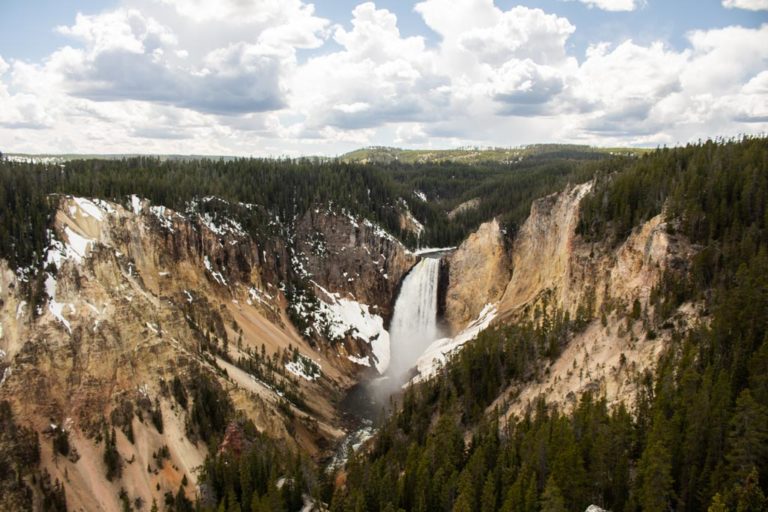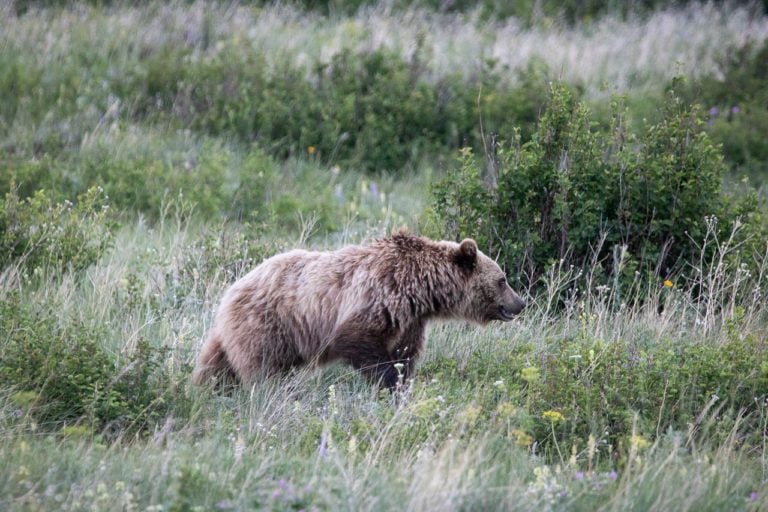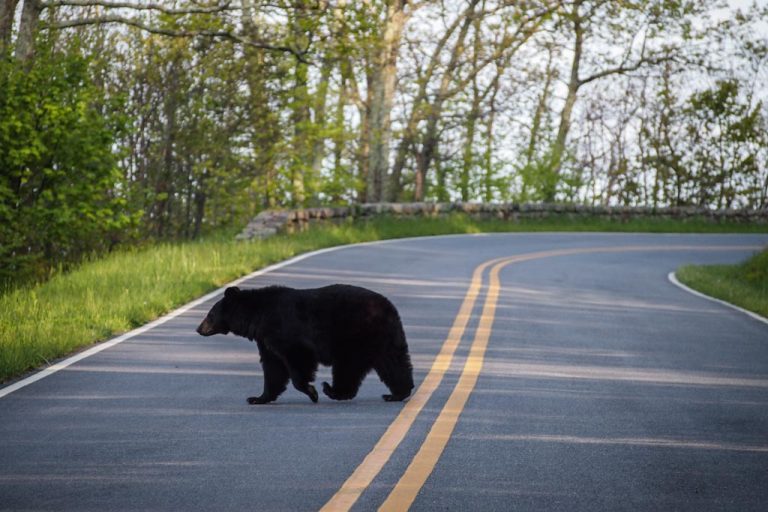Mount Rainier Wildflowers Guide: Viewing Areas, Season, Trails & More
Known far and wide for its beautiful subalpine meadows, spectacular trails, and sensational views, Mount Rainier National Park boasts one of the greatest displays of summer wildflowers in America.
Seeing the kaleidoscopic wildflowers at Mount Rainier is nothing short of awe-inspiring. It’s easily one of the top experiences in the national parks.
Whether it’s getting an up-close view of a tiny mountain sandwort, looking for a flowering Rainiera, or enjoying a sprawling meadow filled with purple lupines, you’ve got endless opportunities to immerse yourself in the wildflower fields of Mount Rainier National Park.
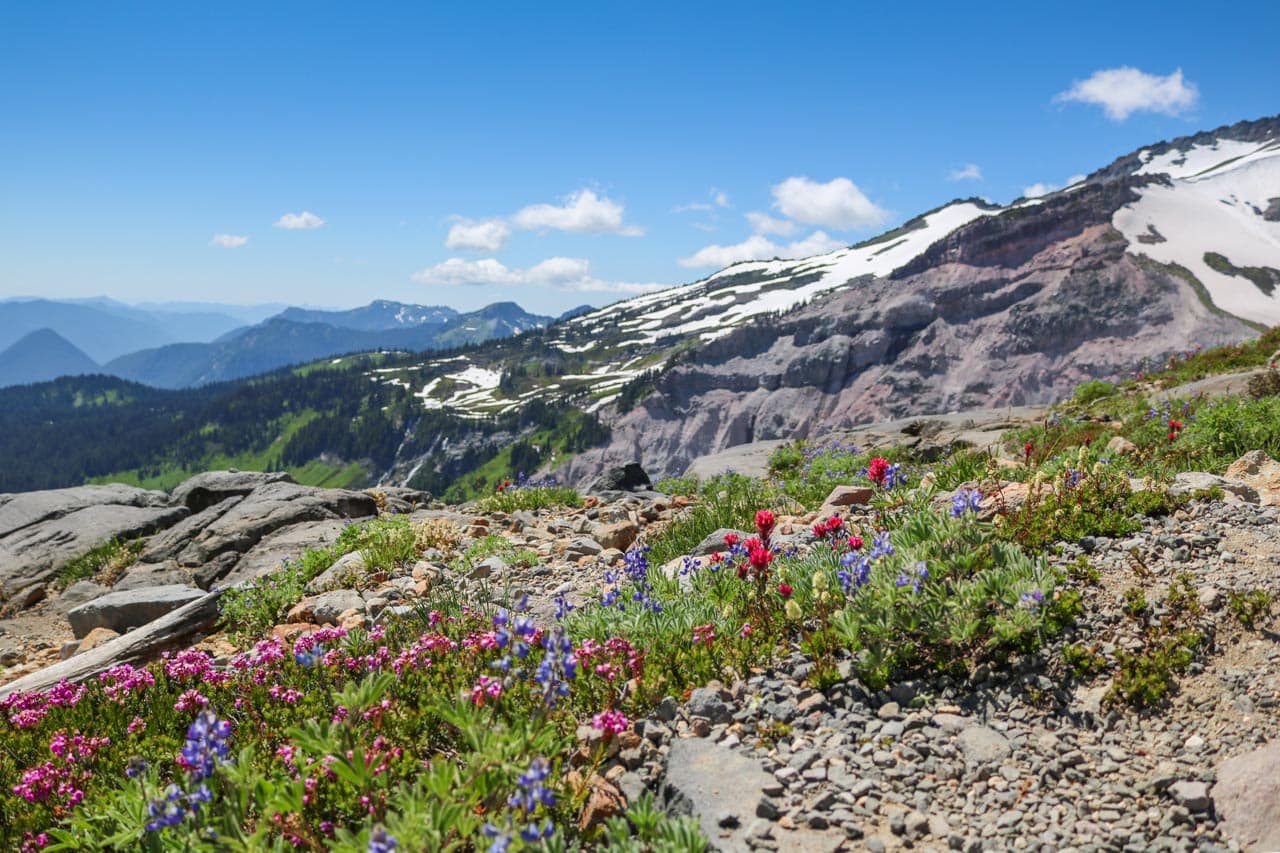
Mount Rainier National Park Wildflower Viewing Guide
This blog post about the amazing Mount Rainier wildflowers contains affiliate links. You can read more about our Terms of Use / Disclosure here.
Below, you’ll find everything you need to know about the famed flowers of Mount Rainier National Park, from the peak wildflower season and popular species to the best viewing areas and hikes.
Note: This article about the Mount Rainier wildflowers focuses on the subalpine wildflowers in the park. While there are also plentiful flowers in the park’s forests and alpine zones, it’s the subalpine meadows or “parklands” that have the most spectacular and diverse wildflower displays.
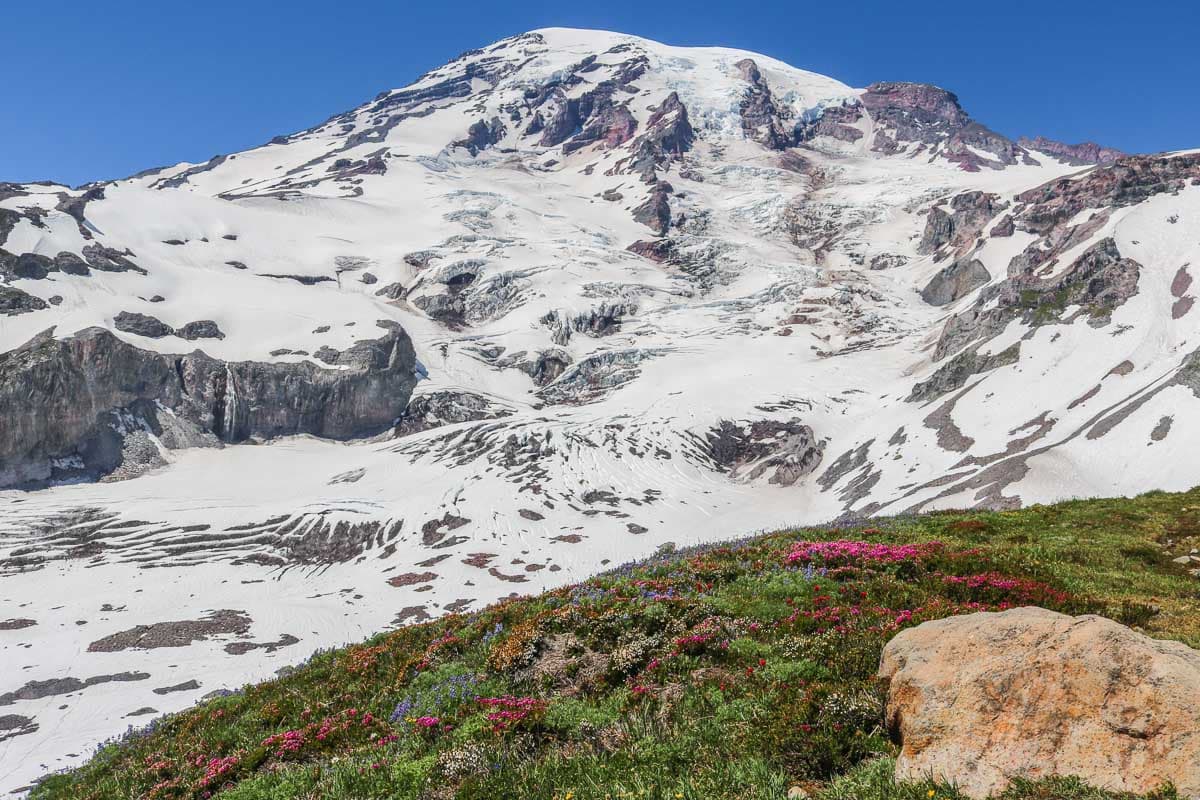
When Is the Peak Mount Rainier Wildflower Season?
Every summer, after the snow has melted at higher elevations, Mount Rainier National Park’s meadows burst into a rainbow-like display of wildflowers.
A few different factors affect when the actual peak bloom occurs every year, such as weather and the thickness of the year’s snowpack. This makes it difficult to provide accurate predictions way in advance.
That said, however, in a typical year “many flowers will be blooming by mid-July, and by the first of August the meadows should be very impressive,” according to park management.
So, generally speaking, the best time to see wildflowers in Mount Rainier National Park is from late-July through mid-August.
Frost can occur as early as late-August in the subalpine meadows, marking the end of the brief summer season. Yet, the meadows stay beautiful even after light frost, according to park management, as colors shift to the yellows and oranges of fall.
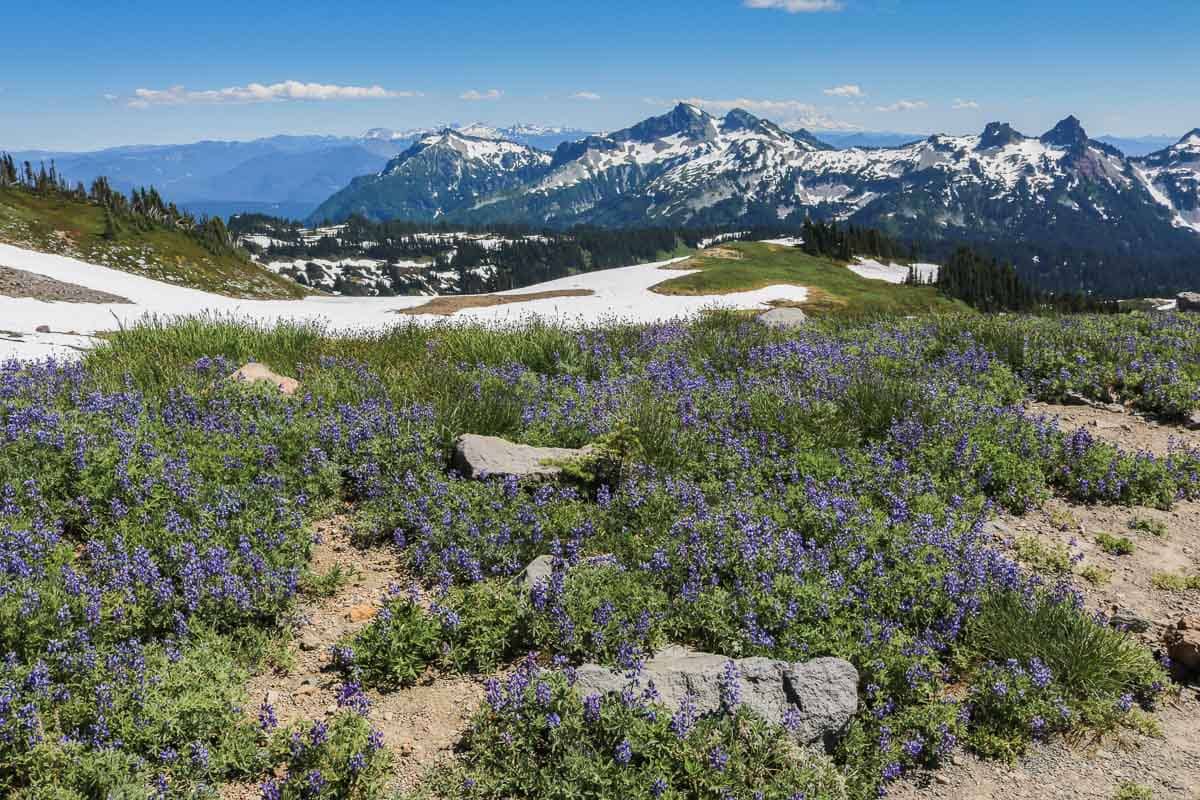
Where Can You See Wildflowers in Mount Rainier National Park?
Although all habitats in Mount Rainier National Park have their own particular flowers, the subalpine meadows are especially amazing in terms of wildflowers.
Located at elevations between 4,500 and 6,000 feet, this is the zone between the dense lower-elevation forests and the treeless alpine areas.
The subalpine meadows are sometimes also referred to as “parklands” because of their combination of meadows, shrubland and patches of trees. They’re mostly sprawling, open areas on the upper slopes of Mount Rainier, dotted with trees, as well as areas of huckleberries and other shrubs.
“Subalpine regions often have the most impressive wildflower displays because those regions have a very short growing season,” the park explains on its wildflower webpage.
“Snow can linger in the subalpine meadows well into June or July, and the flowers bloom profusely in order to reproduce as quickly as possible before the winter snows return.”
Best Places to See Wildflowers in Mount Rainier National Park
There are three particularly popular areas to see the wildflowers in Mount Rainier National Park, all of which are accessible by vehicle:
- 1. Paradise: home to several fantastic wildflower trails, superb views, waterfalls, the park’s main visitor center, and the historic Paradise Inn.
- a. Nisqually Vista Trail
- b. Skyline Trail
- c. Reflection Lakes
- 2. Sunrise: highest point in the park accessible by vehicle, beautiful subalpine meadows, a variety of trails, and visitor services.
- a. Yakima Park
- b. Sourdough Ridge
- c. Berkeley Park
- d. Glacier Basin
- e. Summerland
- 3. Chinook Pass: phenomenal view of Tipsoo Lake and Mount Rainier, relatively small area but home to abundant summer wildflowers, trails range from easy to moderate.
- a. Tipsoo Lake
- b. Naches Peak Loop
In addition to those three Mount Rainier wildflower viewing areas, there are a couple of others that also feature impressive displays of flowers. They’re much more remote, though, and require either a long drive or hike:
- 4. Mowich Lake: remote area in the northwest corner of the park, accessible via a gravel road, with trails leading to wildflower areas such as Spray Park and Eunice Lake.
- a. Spray Park
- b. Tolmie Peak Trail
- 5. Southwest Parklands: trails starting on the road between the Nisqually Entrance and Paradise lead to subalpine “parks.”
- a. Van Trump Park
- b. Indian Henry’s Hunting Ground
Map of Mount Rainier Wildflower Viewing Areas
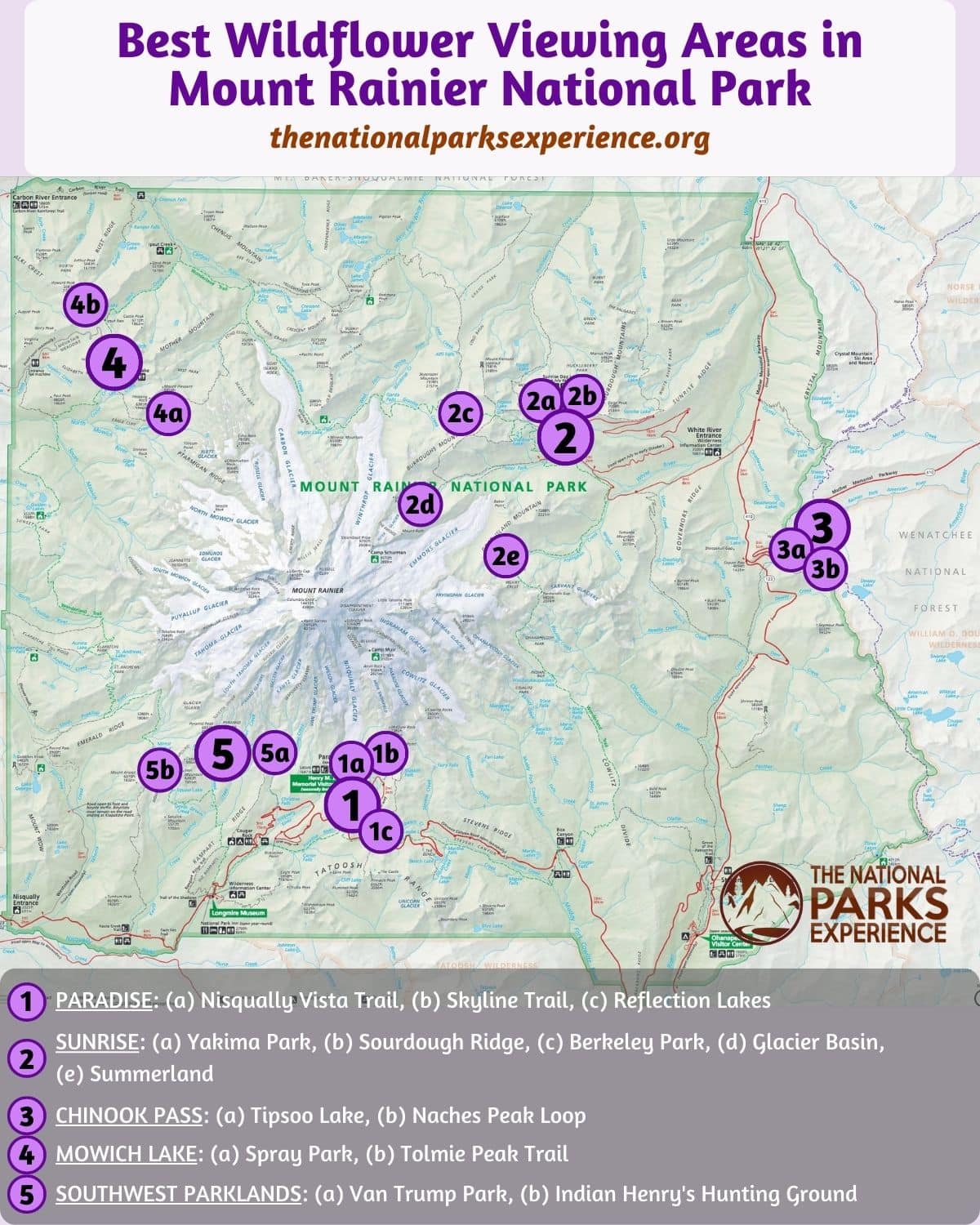
Which Wildflowers Can You See in the Mount Rainier Meadows?
Mount Rainier National Park is home to literally hundreds of species of wildflowers. Many, if not most, of those are found in the park’s subalpine meadows.
While it’s impossible to show or talk about all of them here, I can tell you about several flowers you’re most likely to see during your visit to the park.
Mount Rainier wildflowers cover all colors of the rainbow, from red and yellow to blue and violet, along with numerous white flowers, too. When exploring Mount Rainier National Park, look for these beautiful wildflowers:
WHITE
- Avalanche Lily (Erythronium montanum)
- Bear Grass (Xerophyllum tenax)
- Coiled-beak Lousewort (Pedicularis contora)
- Gray’s Lovage (Ligusticum grayi)
- Marsh Marigold (Caltha leptosepala)
- Mountain Sandwort (Arenaria capillaris)
- Pasqueflower or Western Anemone (Anemone occidentalis)
- Sitka Valerian (Valeriana sitchensis)
- White Mountain Heather (Cassiope mertensiana)
RED & PINK
- Elephant’s Head (Pedicularis groenlandica)
- Magenta Paintbrush (Castilleja parviflora)
- Scarlet Paintbrush (Castilleja miniata)
- Pink Monkeyflower (Mimulus lewisii)
- Pink Mountain Heather (Phyllodoce empetriformis)
- Rosy Spirea (Spirea splendens)
- Spreading Phlox (Phlox diffusa)
- Subalpine Daisy (Erigeron peregrinus)
- Western Spring-Beauty (Claytonia lanceolara var. lanceolata)
YELLOW & ORANGE
- Arrowleaf Groundsel (Senecio triangularis)
- Broadleaf Arnica (Arnica latifolia)
- Fan-leaf Cinquefoil (Potentilla flabellifolia)
- Glacier Lily (Erythronium grandiflorum)
- Mount Rainier Lousewort (Pedicularis rainierensis)
- Oregon Sunshine (Eriophyllum lanatum)
- Rainiera (Rainiera stricta)
- Yellow Willowherb (Epilobium luteum)
BLUE & PURPLE
- Alpine Aster (Oresostemma alpigenum)
- Cascade Aster (Eucephallus ledophyllus)
- Cascade Penstemon (Penstemon serrulatus)
- Broadleaf Lupine (Lupinus latifolius)
- Dwarf Lupine (Lupinus lepidus)
- Common Harebell (Campanula rotundifolia)
- Cusick’s Speedwell (Veronica cusickii)
- Edible Thistle (Cirsium edule)
- Jeffrey’s Shooting Star (Dodecatheon jeffreyi)
- Mountain Bog Gentian (Gentiana calycosa)
- Tall Bluebells (Mertensia paniculata)
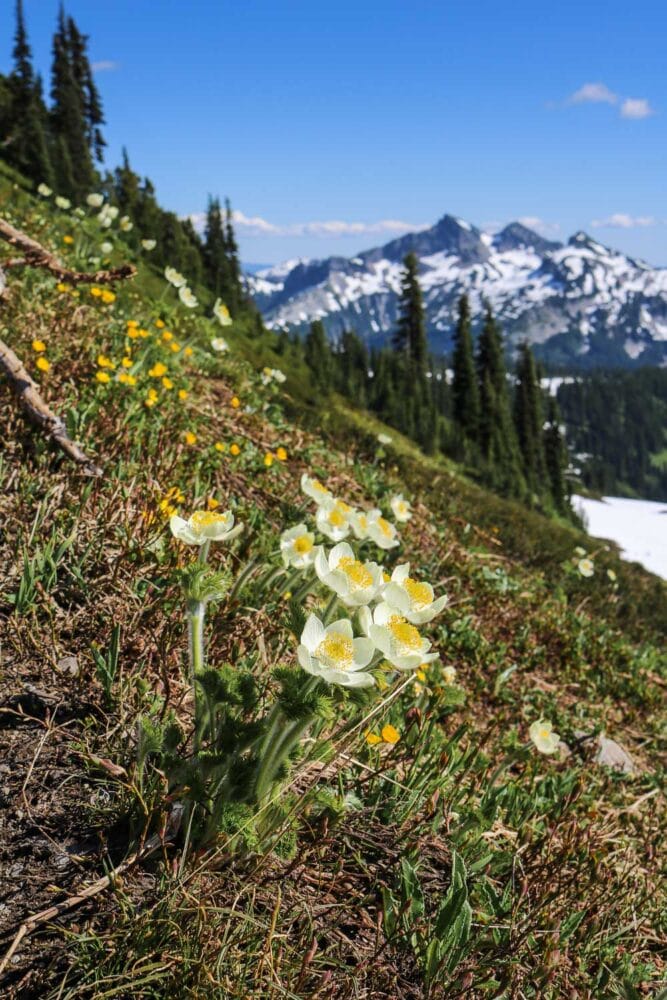
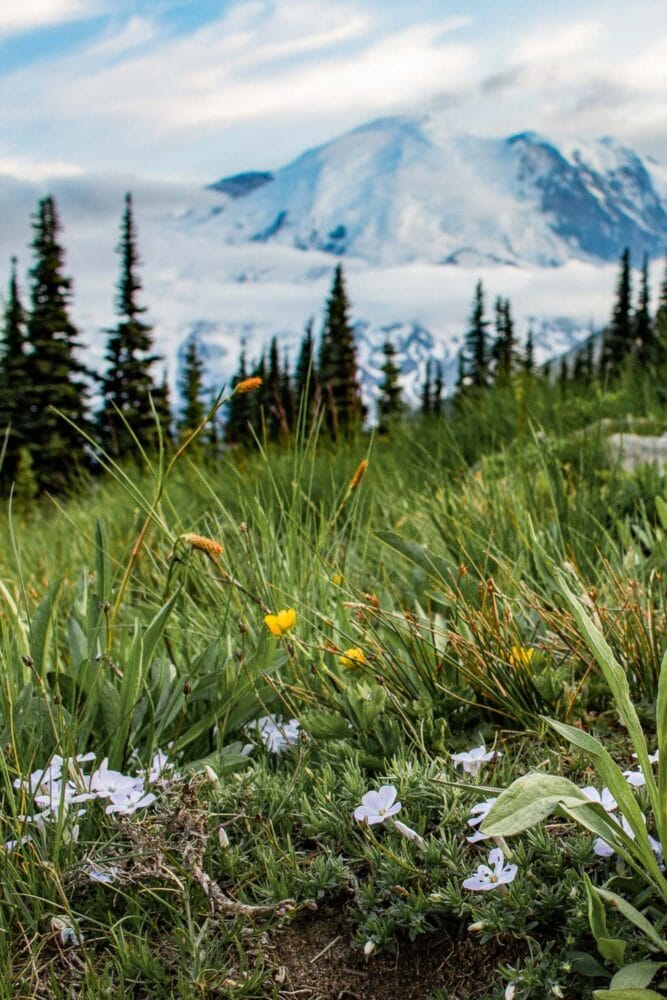
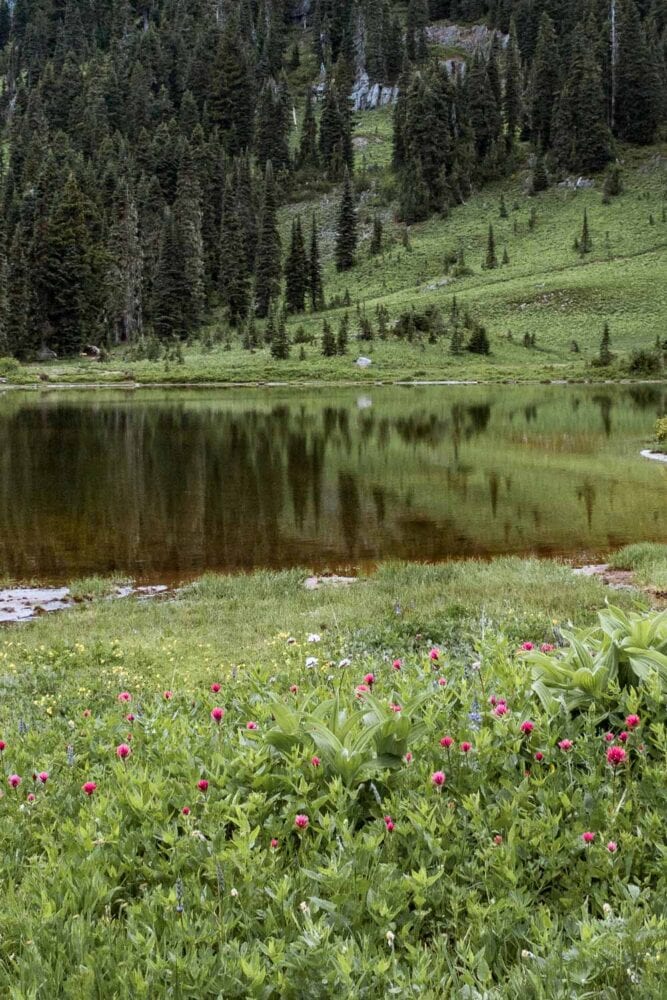
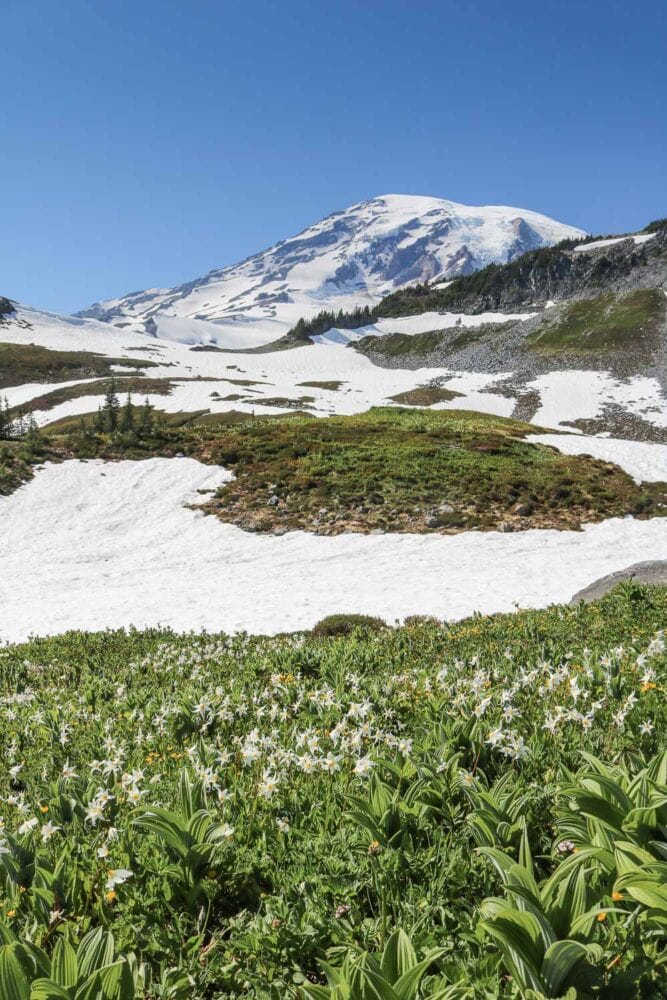
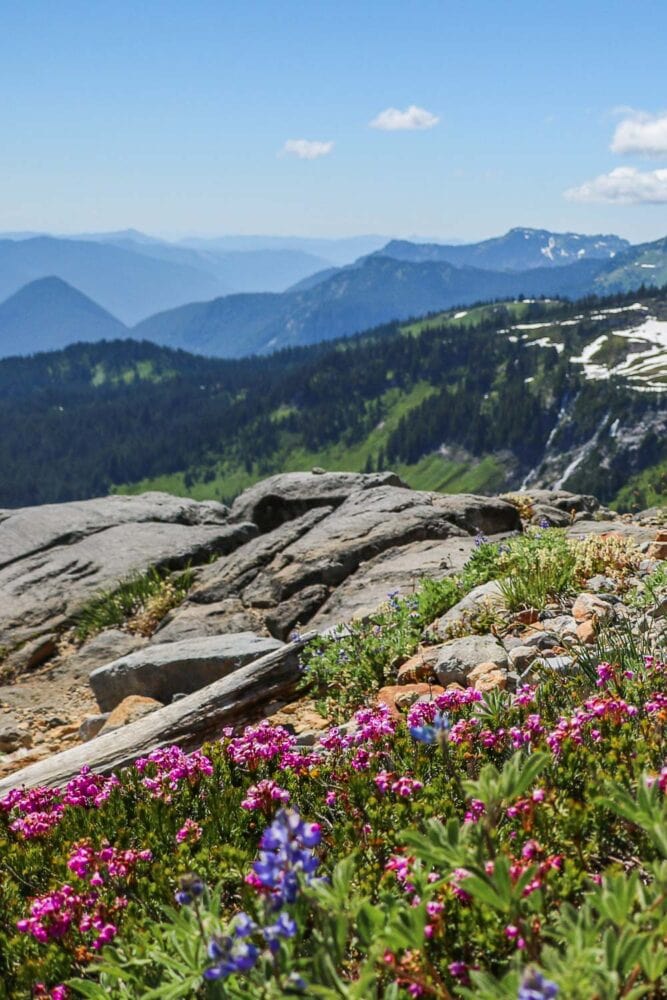
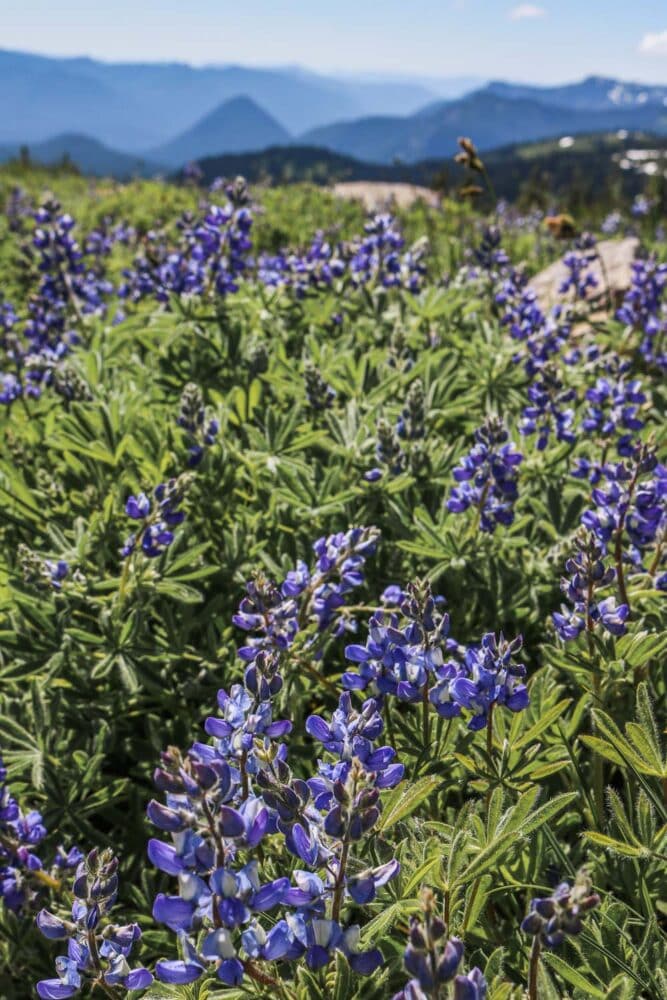
What Are the Best Places for Wildflower Photography at Mount Rainier?
Basically any area that has abundant wildflowers in Mount Rainier National Park is photogenic and picturesque.
From the meadows of Paradise to the slopes at Sunrise and Tipsoo Lake, you can find excellent wildflower photography opportunities throughout the park’s higher elevations.
My personal favorite places to photograph Mount Rainier wildflowers are the following:
- Tipsoo Lake (Chinook Pass, roadside/hike)
- Reflection Lakes (Paradise, roadside)
- Skyline Trail (Paradise, hike)
- Sourdough Ridge (Sunrise, hike)
- Summerland (Sunrise, hike)
- Spray Park (Mowich Lake, hike)
How Much Time Do You Need to Enjoy the Wildflowers in Mount Rainier National Park?
While you can see the beautiful wildflowers of Mount Rainier on just one short hike, or a day visit to places like Paradise and Sunrise, I do recommend spending two or three days in the park.
In summer, the weather is generally excellent, warm and sunny. Sunrises and sunsets in Mount Rainier National Park can be sensational that time of year, especially when the flowers are at their peak bloom.
(Those are the quietest times of the day, too, because most day visitors will either not have arrived yet or have left by then.)
Watching a sunset surrounded by glorious wildflowers at Mount Rainier is an unforgettable experience—trust me on that!
Where Should You Stay For the Best Mount Rainier Wildflower Viewing?
You can choose from a few campgrounds and two lodges within Mount Rainier National Park. I recommend the following for the best wildflower viewing opportunities:
CAMPGROUNDS
- Cougar Rock Campground: near the Wonderland Trail, Van Trump Park Trail, and short drive to Paradise (car campground)
- White River Campground: near Glacier Basin Trail, Summerland Trail, and short drive to Sunrise (car campground)
- Mowich Lake Campground: near the Spray Park Trail and Tolmie Peak Trail (primitive walk-in sites only)
LODGES
- National Park Inn: located in Longmire, near the Wonderland Trail, and short drive to Van Trump Park Trail and Paradise.
- Paradise Inn: located in the heart of Paradise, near the Nisqually Vista Trail, Skyline Trail and other wildflower trails in the area.
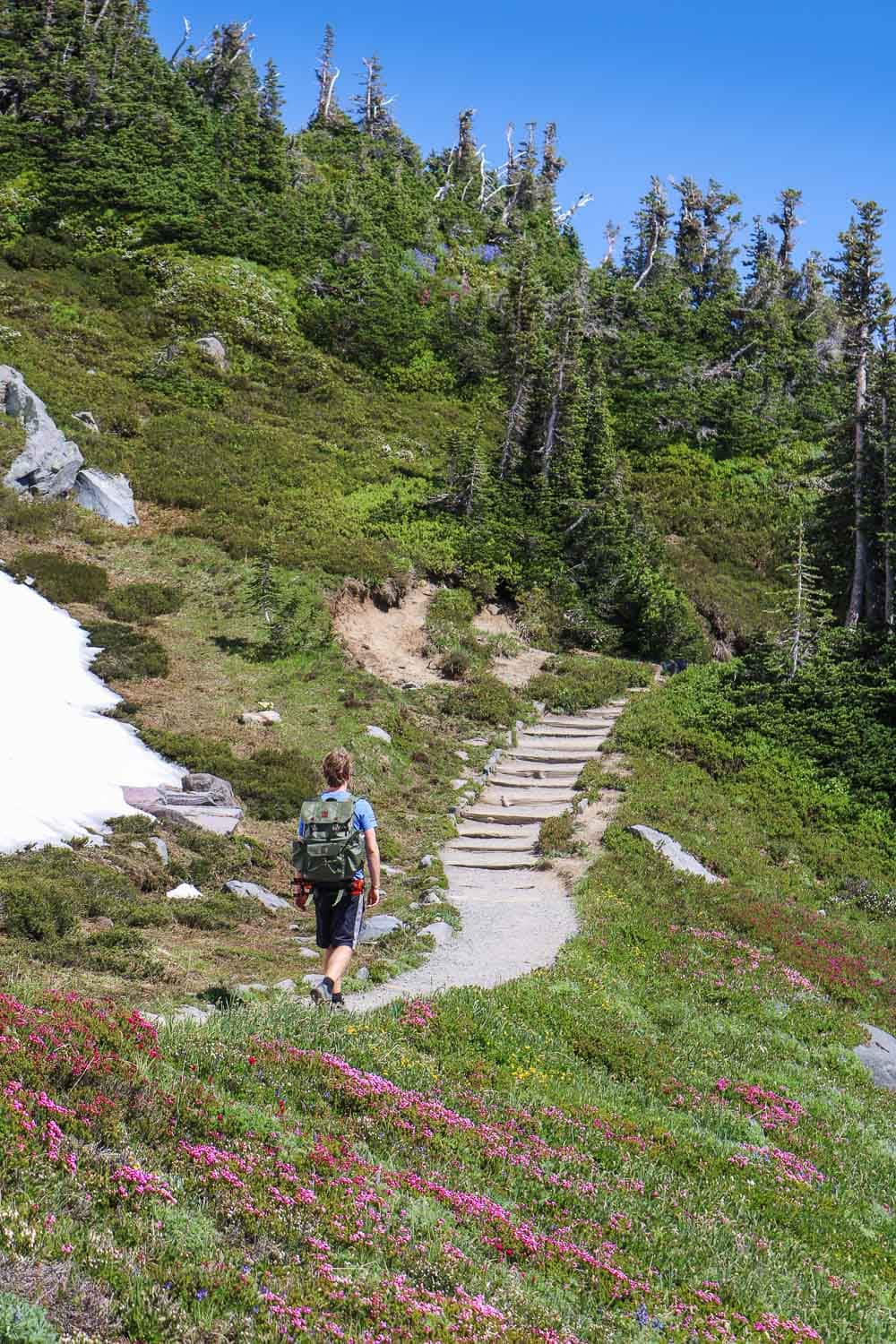
What Are the Best Wildflower Hikes in Mount Rainier National Park?
There are numerous excellent wildflower trails at Mount Rainier. All popular subalpine areas have at least a couple of hiking trails that are worth exploring—most have several.
Here are some of my suggestions for the best Mount Rainier wildflower hikes:
- Naches Peak Loop Trail (Chinook Pass, moderate 3.4-mile loop hike)
- Nisqually Vista Trail (Paradise, easy 1.2-mile loop hike)
- Skyline Trail (Paradise, strenuous 5.5-mile loop hike)
- Yakima Park Trails (Sunrise, network of various easy trails)
- Sourdough Ridge Trail to Dege Peak (Sunrise, moderate 3.4-mile out-and-back hike)
- Glacier Basin Trail (Sunrise, strenuous 7-mile out-and-back hike)
- Summerland Trail (Sunrise, strenuous 8.4-mile out-and-back hike)
- Van Trump Park Trail (between Longmire and Paradise, strenuous 5.8-mile out-and-back hike)
- Wonderland Trail to Indian Henry’s Hunting Ground (Longmire, strenuous 13-mile out-and-back hike)
- Spray Park Trail (Mowich Lake, moderate 6-mile out-and-back hike)
- Tolmie Peak Trail (Mowich Lake, strenuous 6.5-mile out-and-back hike)
What Can You Do to Protect Mount Rainier’s Precious Subalpine Meadows?
“Subalpine plants live by thin margins, facing fierce competition for resources and enduring long winters and harsh conditions. After surviving all this, their greatest threat may be the millions of visitors coming to appreciate them,” the National Park Service says.
To preserve and protect these fragile meadows, the park’s management requires and implores visitors to stay on the trails.
Just staying on the trail is the only thing you have to do to protect Mount Rainier’s wildflowers. It really is that simple.
You can read much more about meadow preservation here on the park’s website.
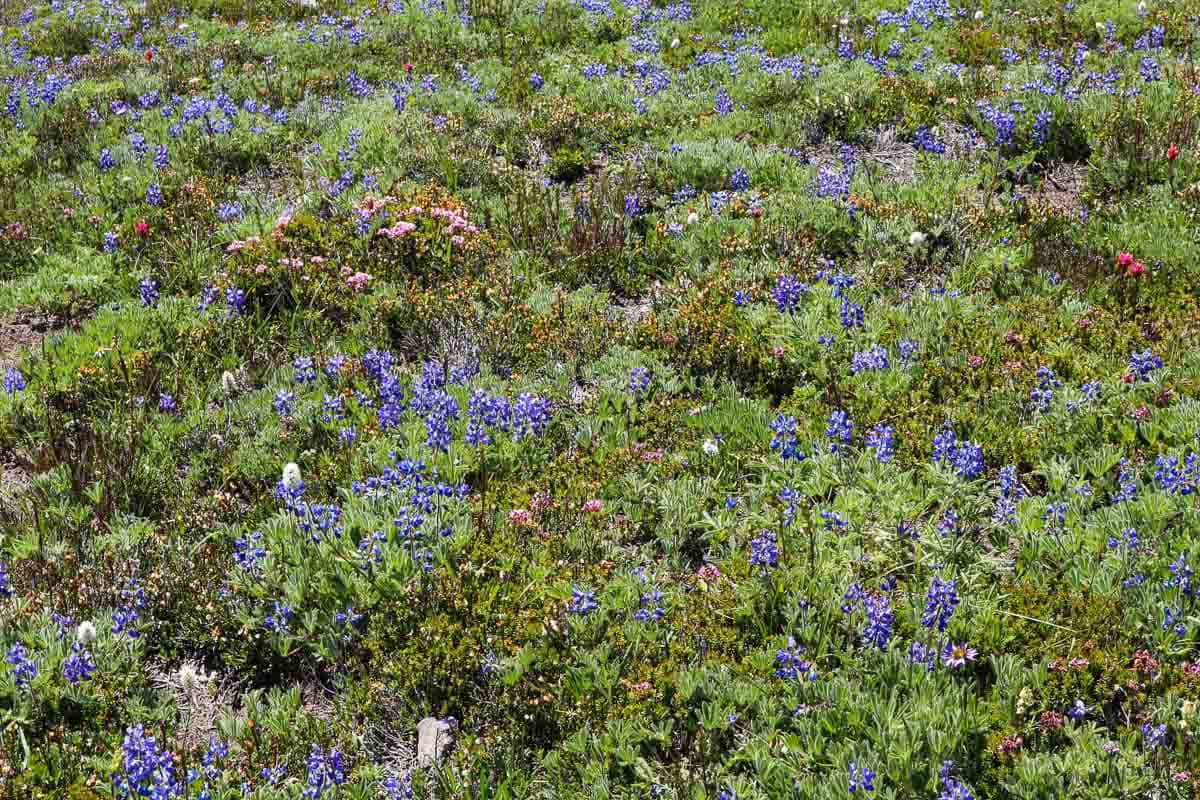
What Is the Current Mount Rainier Wildflower Blooming Status?
For the current wildflower blooming status—what is blooming where at Mount Rainier—you can check the “currently blooming” section here on the park’s website.
More About Mount Rainier National Park
- Park Website
- Travel Guide
- Topographic Map
- Top Things To Do in Mount Rainier National Park
- What to Do at Paradise (Mount Rainier)
- Best Mount Rainier Sunset Spots
- Best Views of Mount Rainier
- Where to See Fall Colors at Mount Rainier
- Accommodation



